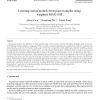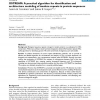1864 search results - page 367 / 373 » Formal topology and domains |
SIGMOD
2010
ACM
13 years 7 months ago
2010
ACM
Information extraction systems are increasingly being used to mine structured information from unstructured text documents. A commonly used unsupervised technique is to build iter...
AI
2007
Springer
13 years 7 months ago
2007
Springer
AI planning requires the definition of action models using a formal action and plan description language, such as the standard Planning Domain Definition Language (PDDL), as inp...
BMCBI
2007
13 years 7 months ago
2007
Background: Relating features of protein sequences to structural hinges is important for identifying domain boundaries, understanding structure-function relationships, and designi...
BMCBI
2007
13 years 7 months ago
2007
Background: Biological sequence repeats arranged in tandem patterns are widespread in DNA and proteins. While many software tools have been designed to detect DNA tandem repeats (...
BMCBI
2008
13 years 7 months ago
2008
To address the challenges of information integration and retrieval, the computational genomics community increasingly has come to rely on the methodology of creating annotations o...



